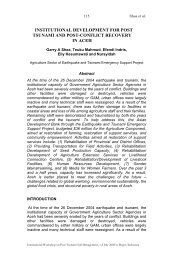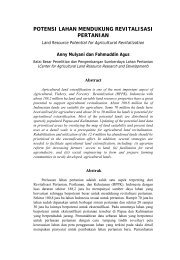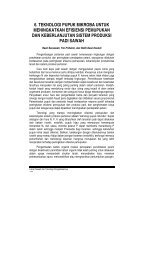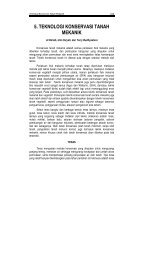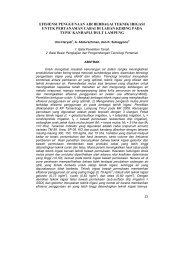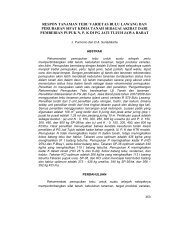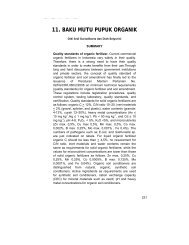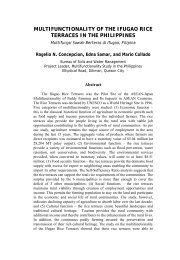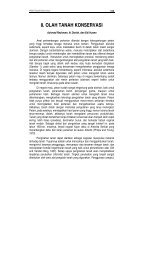Proceedings - Balai Penelitian Tanah
Proceedings - Balai Penelitian Tanah
Proceedings - Balai Penelitian Tanah
Create successful ePaper yourself
Turn your PDF publications into a flip-book with our unique Google optimized e-Paper software.
157<br />
Sammut et al.<br />
Tarunamulia, 2006; Tarunamulia, 2008). The mapping has also<br />
shown that many ponds are excavated in sandy-textured soils,<br />
including sediments that are also classified as ASS due to the<br />
presence of pyrite. Sandy ASS are a significant challenge to the<br />
reconstruction effort because these sediments have both acid and<br />
engineering problems (Sammut and Tarunamulia, 2006).<br />
Soil sampling and mapping sub-programs have been conducted along<br />
the north east coast where most farms are concentrated. A soil<br />
texture model was developed by Tarunamulia (2008) to identify areas<br />
according to their dominant soil texture and associated engineering<br />
constraints. An existing soil model from ACIAR project FIS/97/22 in<br />
South Sulawesi was adapted to map ASS in Aceh. The latter model is<br />
based on information on the association between ASS formation and<br />
distribution with local geology, geomorphology, elevation, vegetation<br />
type and hydrology. Soil models and maps have been extensively<br />
ground-truthed along the north east coast, but west coast mapping of<br />
ASS is currently entirely based on remote sensing, GIS modelling and<br />
past soil data sets (Tarunamulia, 2008).<br />
Acid sulfate soils present a threat to shrimp and fish production in<br />
several ways. Firstly, the acid produced by these soils mobilise metals<br />
which are toxic to shrimp and fish (Sammut, 2000). Aluminium and<br />
iron can cause severe gill damage in shrimp and fish, stunt growth<br />
and reduce beneficial algal blooms. Mass mortalities of stock may<br />
also occur due to osmoregulatory stress through acid and aluminiuminduced<br />
gill lesions (Callinan et al., 2005; Sammut, 2000). Aluminium<br />
also flocculates clays leading to shrinkage and cracking of dyke soils<br />
(Sammut, 2000). Under severely acidic soil conditions, aluminium may<br />
occur as pearly-white aluminium floccules in the less acidic pond<br />
waters. Suspended iron floccules can precipitate or form on pond<br />
walls where they coat benthic algae used in milkfish production or<br />
smother shrimp gills. Iron and aluminium readily strip phosphate from<br />
the water column and consequently reduce the concentration of<br />
beneficial algal blooms (Sammut, 2000). Affected ponds require<br />
higher than normal lime and fertiliser application to neutralise acidity<br />
and maintain sufficient concentrations of phosphate for phytoplankton<br />
blooms (Mustafa and Sammut, 2007; Sammut, 2000). At high<br />
concentrations, iron also coats shrimp and renders them unsaleable<br />
due to the discoloration of the carapace. Iron oxides and jarosite are<br />
commonly formed on the walls of canals and dykes. The presence of<br />
these minerals is a good indicator of advanced pyrite oxidation in soils<br />
(Dent, 1986; Sammut et al., 1996). High concentrations of metals in<br />
ASS are also a bioaccumulation risk in shrimp, fish and seaweed<br />
culture (Gosavi et al., 2004).<br />
International Workshop on Post Tsunami Soil Management, 1-2 July 2008 in Bogor, Indonesia



